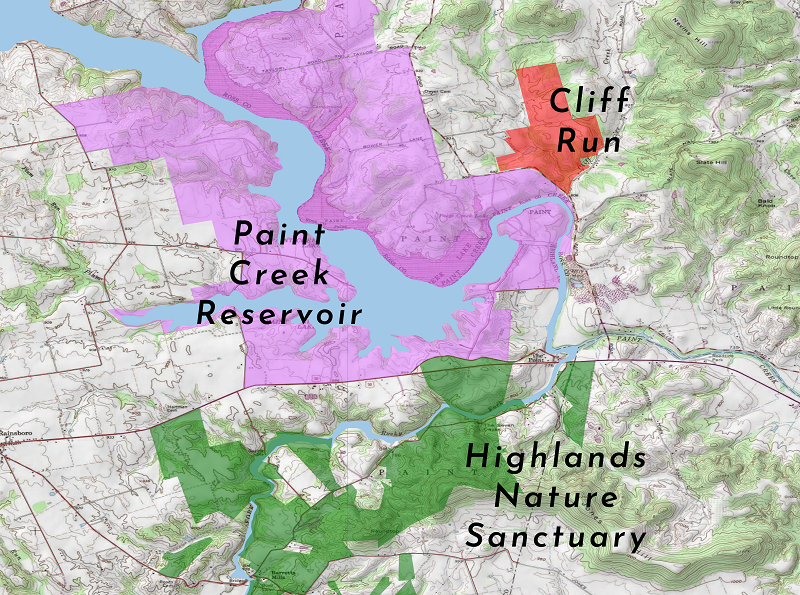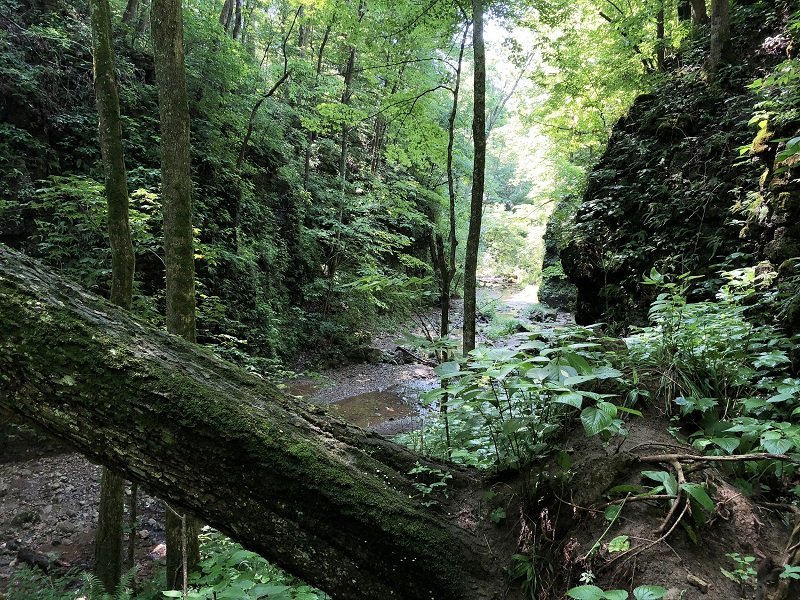Cliff Run Cascades. Photo by Lewis Ulman.
Cliff Run
a 300-acre preserve in Ross County
Cliff Run Preserve is a Clean Ohio-assisted project that lies just east of Paint Creek State Park, on the eastern edge of Paint Creek Dam. The preserve protects two waterways, Cliff Run and Lewis Gorge, each of which boasts an impressively deep vertical-sided gorge. Both waterways showcase what is indisputably some of the most beautiful geologic scenery in the state of Ohio
The Cliff Run Preserve is dizzy with signature showcases for karst country’s showy botanicals in the spring. So profuse are its wildflowers, that even before the property was purchased, the previous owners permitted the gorge to be used as one of the field trip destinations for our annual Wildflower Pilgrimage. Many species of flowers cling to 50-foot cliffs that border the limestone-bottomed creek.
The Arc’s land stewardship team is in the process of developing the preserve with an exceptionally beautiful public hiking trail that is scheduled to open in 2025.
This project was funded in part by a grant from Clean Ohio.
Project Cost Entire Preserve: $1,242,510
Current balance yet to raise: $39,253








A Premier Karst Landscape. Cliff Run Preserve is a prime example of a classic karst ecosystem, complete with Silurian-aged Peebles Dolomite limestone bluffs, sinkholes, seeps, springs, grottos, and a mile of vertical-walled dolomite canyon. Karst is an uncommon landscape type in Ohio. Most of the state’s limestone and dolomite rocks are buried under several meters of glacial till, and thus there is insufficient limestone/dolomite bedrock exposed in most regions of the state to display classic karst-landscape characteristics. The limestone/dolomite karst bluffs and waterways found at Cliff Run support a high diversity of native plants and animals, representing an intact and healthy native ecosystem as evidenced by its rich spring wildflowers, high water quality, and representation of tree species diversity.
Cliff Run Preserve’s Outstanding Spring Wildflowers. Wildflowers are one of the best indicators of an intact forest ecosystem. When a forest is negatively impacted by human activities, it shows up most dramatically and visibly in a) soil health, b) water quality, and c) plummeting understory biodiversity. All three of these indicators of forest health are revealed in the quality of a site’s native wildflowers. High wildflower diversity always reflects a healthy forest community.
The entire Cliff Run Preserve area boasts one of the densest spring wildflower displays in a region already renowned for its wildflower displays, a region that includes the nearby Highlands Nature Sanctuary and Paint Creek Reservoir, shown on the map above. Many of the signature plants found at Cliff Run Preserve are adapted to high-alkaline habitats, including hepatica, columbine, smooth cliff brake, Sullivantia, and walking fern.
Cold Water Streams: The protected watershed of Cliff Run takes in a section of Cliff Run proper, and the beautiful side gorge of Lewis Family Gorge. The striking beauty of the gorge’s vertical dolomite cliffs and the pavement-like level rock bottom was what inspired the pursuit of this preserve. Lewis Family Gorge’s waterway is particularly pristine, and both the gorge and the beautiful ravine carved by Cliff Run support rich macroinvertebrates and cold-water adapted fauna, including the mottled sculpin.
Visitor Services Planned for Cliff Run. The Arc’s goal has long been to establish a public hiking trail at Cliff Run Preserve. Our Land Stewardship Team has been pouring its artistry into Cliff Run’s trail design. They contracted with a mason to build concrete steps leading down to the canyon floor. With their own hands and those of volunteers, they constructed a 280-foot-long floating bridge, giving hikers access to the small lake without interfering with the beavers who have remodeled the lake to their liking. They also built a gorgeous 45-foot footbridge spanning Cliff Run proper, supported by I-beams they repurposed from an abandoned trailer. The trail is scheduled to open in spring, 2025.

